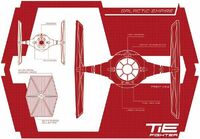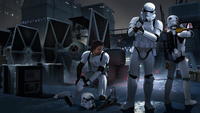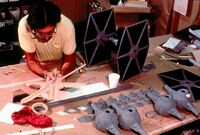Warning: This infobox has missing parameters: type and unrecognized parameters: modules, class, era
- "You always hear them first. Twin ion engines make TIE fighters howl as they fly by on patrols."
- ―Ezra Bridger
The TIE/LN starfighter, commonly known as the TIE fighter, was the signature starfighter of the Galactic Empire. Instantly recognizable from the roar of their engines, they exuded Imperial power and prestige across the galaxy, seeing use throughout the Empire's political existence.
Characteristics
- "Get your hands off my craft! This fighter is property of the Empire!"
- ―Baron Valen Rudor

Technical drawing of a TIE/LN starfighter
The TIE/LN starfighter was a small, short-range fighter developed, manufactured, and mass produced by Sienar Fleet Systems. Developed by SFS company head Raith Sienar,[2] the basis for the TIE fighter can be traced back to Kuat Systems Engineering's Alpha-3 Nimbus starfighter, along with several other outmoded models from the Old Republic. Like their predecessors, TIE's employed two vertical wings similar in appearance to V-wing starfighters, however the Eta-2 Actis-class light interceptor bore even more similarities with its central cockpit pod, twin ion engines and common weapons technology.[3]
The TIE/LN measured 8.99 meters in length,[4] and could attain a maximum speed of 1,200 kph.[5] It was propelled by two P-s3 ion engines, which would be replaced by twin P-s4 ion engines approximately five years before the Battle of Yavin.[7]

A Rebel T-65B X-wing starfighter in the sights of a TIE fighter's targeting computer.
A TIE fighter's twin ion engines provided thrust and boosters capable of quickly adjusting the ship's direction, however in order to minimize power drain, the TIE lacked key systems such as deflector shields and hyperdrives. The fighter's black wings were in fact an array of twelve solar collectors that pooled power and directed it to the fighter's twin engines and twin L-s1 low-temperature laser cannons.[13] It's central cockpit was tightly fitted, incorporating flight controls, viewscreens, targeting systems, tracking equipment—including a homing beacon in case the vessel was stolen—and room for a pilot all in the central pod.[11] Despite being designed for a single occupant, several other passengers could fit inside the central cockpit, although the fit would be extremely tight.[11] Flight controls on the other hand were considered intuitive and easy to learn, in some cases allowing rebel novices to fly and operate them after having stolen them from Imperial airfields. TIEs were also outfitted with an ejector seat and twin low-temperature laser cannons mounted to the 'chin' section of the cockpit module.[3] The fighter could also feature a single proton torpedo launcher.[9]
During the reign of the Empire, TIE fighters were favored for their versatility, if not for their durability. They were able to operate both in space as well as in planetary atmospheres, acting as fighters or scouts.[14] One great advantage of the TIE fighter was the fact that it was not simply limited to linear flight, like other fighters of its time. On occasion the fighters demonstrated ability to hover in place and even fly completely sideways, adding to the usefulness of the fighter as a scout vehicle.[11]
At least a month after the Battle of Jakku, all TIE/LN starfighters were upgraded with advanced weaponry invented by Ved Foslo, allowing them to punch through an enemy fighter's shields as well as hull, destroying them in a single hit.[15]
History
Following the transformation of the Galactic Republic into the authoritarian Galactic Empire, Republic era weapons and equipment would continue to be utilized throughout the Imperial sphere. As time went by, the Republic's Eta-2 Actis-class light interceptor and ARC-170 starfighters began to be phased out roughly five years after the proclamation of the New Order. It's replacement, the TIE/LN starfighter would retain similarities to the old craft, with Sienar Fleet Systems having borrowed heavily from the designs of Kuat Systems Engineering ships, thanks to acquiring key assets and engineers employed by their competitor.[3]

TIE fighters stationed at an Imperial airfield.
With TIE pilots instructed to ignore their own well-being in order to achieve their objectives, the fighters were extremely fragile and their pilots expendable. With the Imperial Navy's vast size and unchallenged reign over the galaxy, the use of swarm tactics and subsequent mass production and refreshment of the vessels barely put a dent into Imperial manpower and industrial capacity. As a result, many features were sacrificed to facilitate mass production by Sienar Fleet Systems factories, even causing Wilhuff Tarkin to dread the thought of ever having to pilot one due to its cramped cockpit.[3][16] Imperial fighters also acted as psychological deterrents to potential seditious activities, with their roaring engines inspiring fear in those who heard them, leading to Imperial commanders to purposely order their pilots to fly low over areas that needed reminding of Imperial might.[15]
As part of the five-year plan for the industrialization of the Outer Rim Territories, TIE fighters were produced on a number of planets, including Lothal.[17] The Empire also gave some of its TIE fighters to loyalist companies to help secure its interests, leading to variants such as the Mining Guild TIE fighter.[13]
Following the destruction of the first Death Star, the classification between Army and Navy pilots—referred to as ground-hogs and vac-heads respectively—was rescinded, and the Imperial Military was to undergo a mass reorganization.[18]
Over time, a variety of other models arose from the TIE line, including notable vessels such as the TIE/IN interceptor, TIE/sa bomber, TIE striker, and TIE/D Defender, partly in direct response to faster and newer vessels manufactured by the Rebel Alliance. By the time of the Battle of Endor, these newer vessels made up approximately 20% of the Empire's starfighter fleet.[19] Despite this, a variety of sub-models of the TIE line had arisen throughout Imperial history, with Sienar factories experimenting with localized improvements, producing advanced models suited to flying in local conditions and incorporating secret technological breakthroughs. Ships such as the TIE Advanced v1 fighter would see use by barons and high-ranking members of the Inquisitorius, however its extreme cost would later relegate its successor, the TIE Advanced x1 to be flown only by elite pilots and members of the Imperial hierarchy such as Lord Vader.[3]
Following the Battle of Endor, Imperial supply shortages would hinder the production and further development of TIE/LN starfighters, forcing Imperial-class Star Destroyers to make due with an inadequate number of ships and inexperienced pilots.[10]
Legacy
The legacy of the TIE fighter was not forgotten on the galactic stage, with Sienar Fleet System's successor, Sienar-Jaemus Fleet Systems producing the latest-generation TIE fighters utilized by the Empire's successor state, the First Order. The TIE/sf space superiority fighter and TIE/fo space superiority fighter were a direct continuance of the imprint the TIE fighter had on galactic citizenry, and featured advanced weapons systems and a two-seated arrangement for use by the Order's Special Forces.[20]
Future historians would argue that flaws inherent in the TIE fighter design were allowed to remain, if only to increase the Empire's dependency on Sienar Fleet Systems for continued production of the craft, along with increased dependency on Kuat Drive Yards capital-scale carrier ships.[21]
Behind the scenes

TIE fighter models being constructed for A New Hope.
Industrial Light & Magic's (ILM) Colin Cantwell created the concept model that established the TIE fighter's ball-cockpit and hexagonal panels design for A New Hope.[22] Sound designer Ben Burtt created the distinctive TIE fighter sound effect by combining an elephant call with a car driving on wet pavement.[23]
The original TIE/ln fighters seen in A New Hope were relatively white in color, but were originally meant to have a maroon hull. One of the benefits of a slightly reddish color would have been that the fighter models would not have been as prone to "blue spill" as gray models were during filming against a blue screen. However, during film composition tests, it was discovered that the maroon color caused the ships to blend too quickly into the mostly black star field when moving away from the camera, so a light gray color was used instead.[24] The TIE fighter models featured in The Empire Strikes Back and Return of the Jedi were blue-gray in color.
Combat scenes between TIE fighters and the Millennium Falcon and Rebel Alliance X-wing fighters in A New Hope were meant to be reminiscent of World War II dogfight footage; editors used World War II air combat clips as placeholders while Industrial Light and Magic completed the movie's special effects.[25]
TIE/LN fighters are one of two starships available to Imperial players in Star Wars Battlefront, the other being the TIE/IN interceptor. Compared to the X-wings and A-wings, TIE fighters lack shields but instead possess good maneuverability and speed. However, their large wing panels make them very easy to hit in dogfights, giving Rebel fighters a slight advantage in ship-to-ship engagements.
In Ultimate Star Wars, it was stated that TIE fighters built on Lothal had shorter wings. However, in ![]() Rebels Recon: Inside "Always Two There Are" on StarWars.com (backup link), it was said that there is no difference. Since then, Pablo Hidalgo confirmed on Twitter that Ultimate Star Wars was incorrect.[26]
Rebels Recon: Inside "Always Two There Are" on StarWars.com (backup link), it was said that there is no difference. Since then, Pablo Hidalgo confirmed on Twitter that Ultimate Star Wars was incorrect.[26]
Appearances
Non-canon appearances
- LEGO Star Wars Movie Short (2015 Episode 10: Rebels Raw Deal)
- LEGO Star Wars: The Freemaker Adventures
